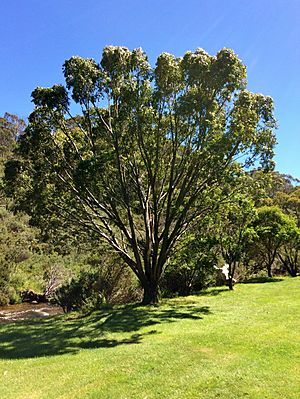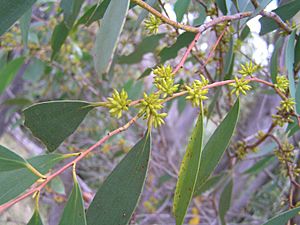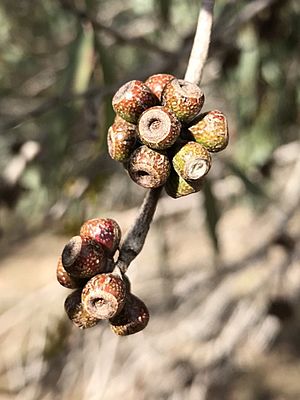Black sallee facts for kids
Quick facts for kids Black sallee |
|
|---|---|
 |
|
| Eucalyptus stellulata near Thredbo | |
| Scientific classification | |
| Genus: |
Eucalyptus
|
| Species: |
stellulata
|
The Black Sallee (scientific name: Eucalyptus stellulata) is a type of small tree or a mallee (a shrubby tree). It grows only in the higher, cooler parts of south-eastern Australia. This tree has rough bark at the bottom, smooth green bark higher up, and long, narrow leaves. It produces white flowers in groups and small, round fruits.
Contents
What the Black Sallee Looks Like
The Black Sallee can grow up to 15 m (49 ft) tall. It often has a special woody swelling at its base called a lignotuber, which helps it regrow after fires.
Bark and Leaves
- The lower part of the trunk has rough, greyish bark that feels a bit like short fibers.
- Higher up, the bark is smooth and olive green, sometimes looking a bit oily.
- Young plants have oval-shaped leaves that grow in opposite pairs. These leaves are about 40–100 mm (1.6–3.9 in) long and 30–50 mm (1.2–2.0 in) wide.
- Older trees have glossy green leaves that are long and narrow, like a spear. They are about 47–110 mm (1.9–4.3 in) long and 9–32 mm (0.35–1.26 in) wide.
- The veins in the leaves are almost parallel to each other.
Flowers and Fruit
- The flower buds grow in star-like clusters of nine to fifteen buds. They are found where the leaves meet the stem.
- Each cluster sits on a short stalk, about 1–6 mm (0.039–0.236 in) long.
- The mature buds are shaped like a spindle, about 4–6 mm (0.16–0.24 in) long, with a pointed cap.
- Black Sallee trees usually flower between February and May. Their flowers are white.
- After flowering, the tree produces small, cup-shaped or round fruits. These fruits are about 3–5 mm (0.12–0.20 in) long and wide.
About Its Name
The scientific name Eucalyptus stellulata was first given to this tree in 1828 by a botanist named Augustin Pyramus de Candolle.
Meaning of Stellulata
- The word stellulata comes from a Latin word meaning "little star."
- This name refers to how the flower buds look when they are clustered together, like tiny stars.
Meaning of Sallee
- The common name "sallee" or "sally" comes from old British words.
- These words were used to describe a "sallow" tree, which is a type of willow tree that often grows low or like a shrub.
Where the Black Sallee Grows
The Black Sallee is found in south-eastern Australia.
- It grows from near Tenterfield in New South Wales.
- It continues south along the Great Dividing Range into the eastern highlands of Victoria.
- You can often find it in grassy eucalyptus woodlands, especially near swamps and streams.
- It prefers soils that are quite fertile.
Gallery
- Features of the black sallee (''Eucalyptus stellulata'')

All content from Kiddle encyclopedia articles (including the article images and facts) can be freely used under Attribution-ShareAlike license, unless stated otherwise. Cite this article:
Black sallee Facts for Kids. Kiddle Encyclopedia.




